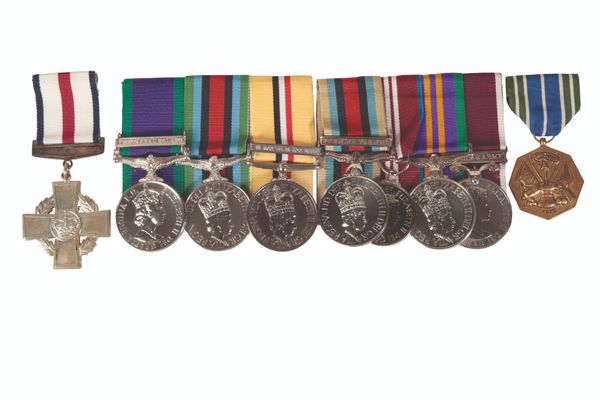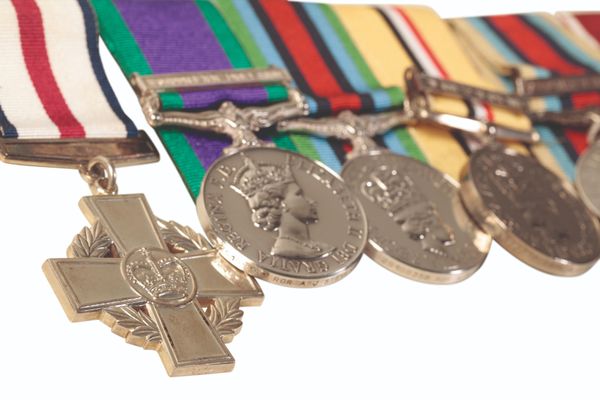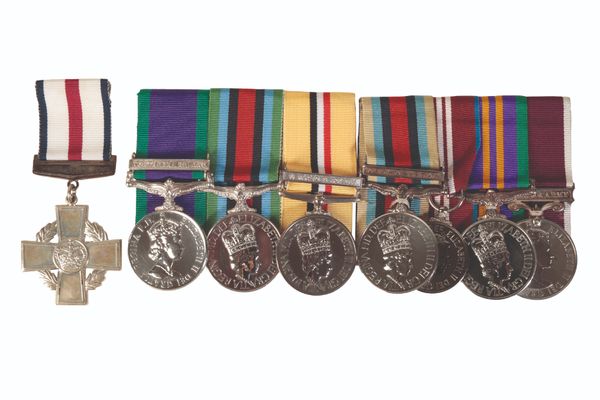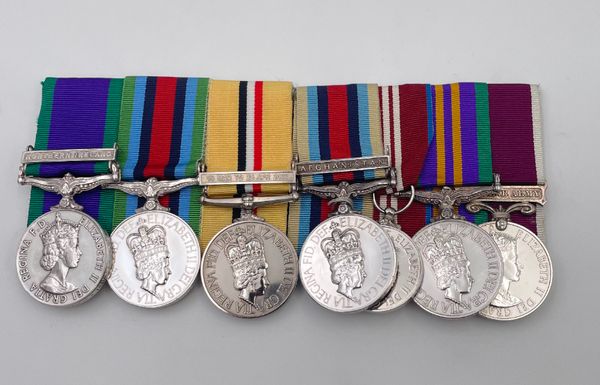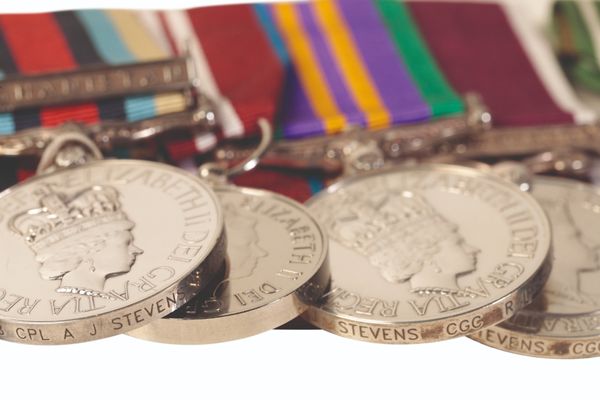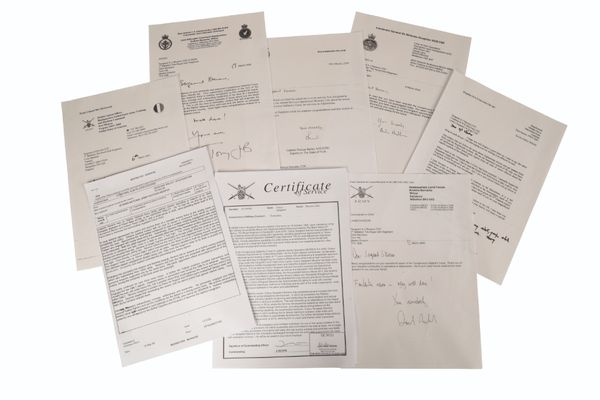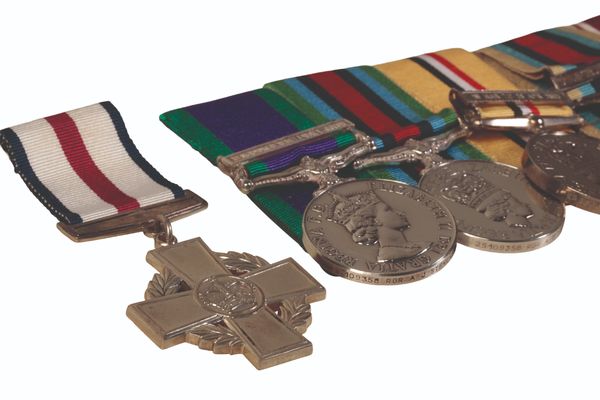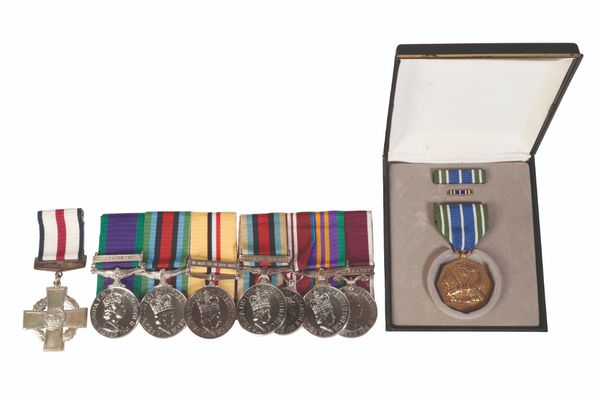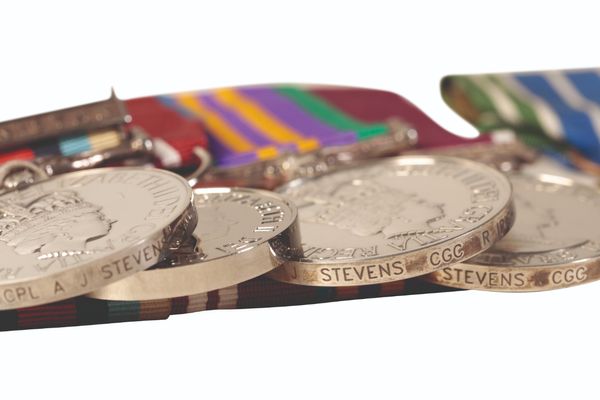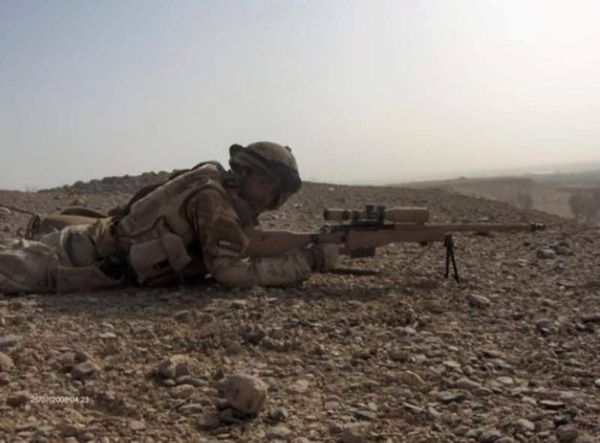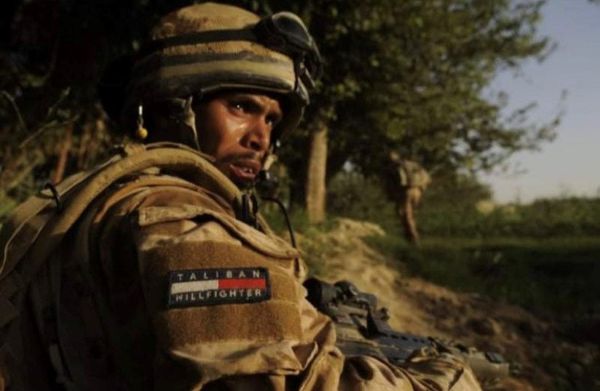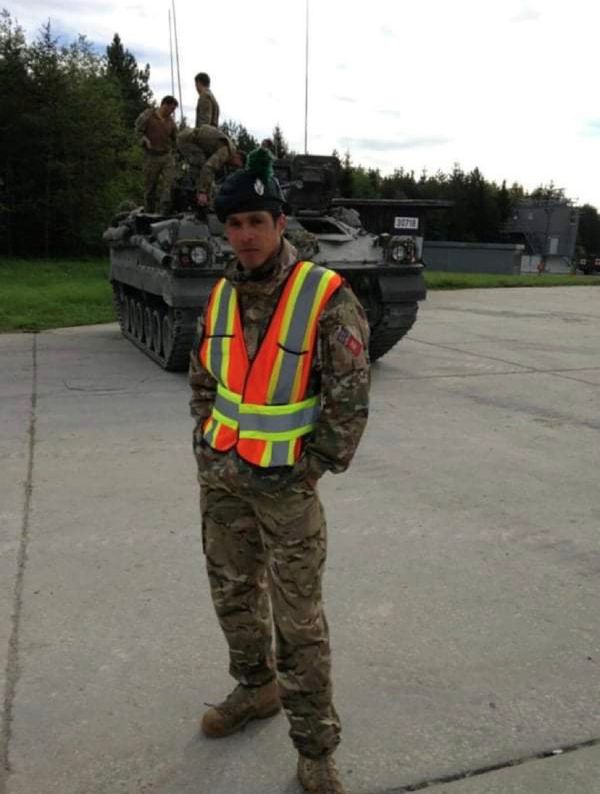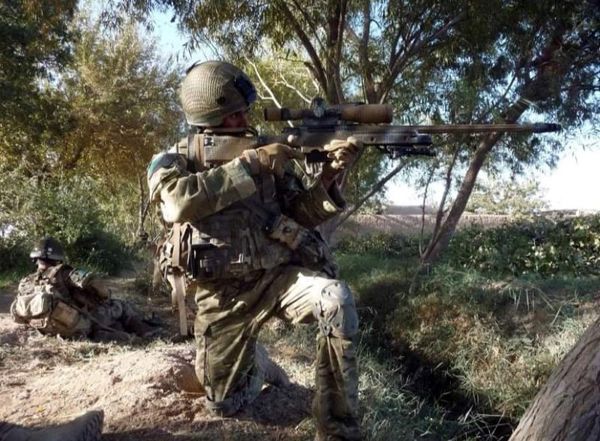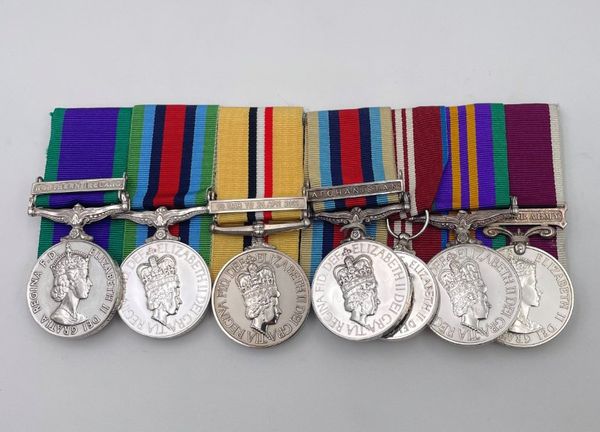Awarded to Corporal later Colour Sergeant A.J. Stevens Royal Irish Regiment.
E.I.I.R. Conspicuous Gallantry Cross. Correctly inscribed to the reverse 'SGT A J Stevens R Irish 25109358 2009'
CSM Northern Ireland. Correctly impressed '25109358 RGR A J Stevens R Irish'
OSM Sierra Leone. Correctly impressed '25109358 RGR A J Stevens R Irish'
Iraq Medal with bar 19 Mar to 28 Apr 2003. Correctly impressed '25109358 L/Cpl A J Stevens R Irish'
| Estimate: | £120,000 - £140,000 |
| Hammer price: | £120,000 |
OSM Afghanistan. Correctly laser engraved ' 25109358 Cpl A J Stevens R Irish'
E.I.I.R 2012 Diamond Jubilee Medal. Unnamed as issued.
Accumulated Campaign Service Medal. Correctly laser engraved ' Cpl A J Stevens CGC R Irish 25109358'
Regular Army Long Service Good Conduct Medal. Correctly laser engraved.' SGT A J Steven CGC R Irish 25109358'
Mounted for display. Condition EF.
'I came across them, shot them three and called airstrikes on their positions. The training kicks in, you rehearse your drills in the UK, and you rehearse and rehearse. That is what keeps you alive, and then the adrenaline kicks in. You don't have much time to think, it is more of a reaction, but if I hadn't done what I did, I probably wouldn't be here today.'
'Stevens displayed extraordinary courage, selflessness and leadership. He personally engaged and killed several Taliban Fighters and set conditions for the defeat of a strong enemy force. His actions ensured the enemy never again appeared in such strength in the ATTAL area during Op HERRICK 8'.
Alwyn John Stevens was born on St Helena, a British overseas territory in the South Atlantic. He joined the Army on 18th of October 1999.
Stevens was only a few weeks out of basic training when he deployed to Sierra Leone. He completed six tours of Northern Ireland, provided support in Leeds during the Fire Fighters Strike of 2002 and completed tours of Iraq and Afghanistan. He qualified as a Sniper in 2006 and became a Sniper Platoon Commander in 2014. A role in which he continued to serve until just before being discharged from the Army in mid-October 2021 after 22 years’ service.
The following is taken from his certificate of service;
'25109358 Colour Sergeant Stevens enlisted in the Army on 18 October 1999. Upon completion of his basic training, he joined the Royal Irish Regiment before being seconded to The Black Watch, 3rd Battalion, The Royal Regiment of Scotland, in June 2019. Colour Sergeant Stevens has provided 22 years of distinguished service across both regiments, including operational deployments to; Sierra Leone, Northern Ireland (Operation Banner), Iraq (Operation Telic) and Afghanistan (Operation Herrick). He has experience operating in a wide variety of environments, in both the UK and overseas, as part of a close-knit team that must work in fast-paced, ever-adapting situations, often under significant physical and mental pressure.
Awarded the Conspicuous Gallantry Cross for gallantry during Operation Herrick 8, Colour Sergeant Stevens has proven an outstanding soldier. As the sniper platoon commander, he has been superb in developing and leading a team of 17 junior soldiers. His considered and empathetic approach to leadership has been key in maintaining his soldier's effectiveness whilst held at high readiness for NATO taskings under the Vanguard Joint Task Force (Land).
Colour Sergeant Stevens has been a key member of the battalions middle management team and holds the respect and confidence of the entire chain of command. For his service Colour, Sergeant Stevens has been awarded the Operational Service Medals for Sierra Leone and Afghanistan, as well as the Operational Telic Medal (Iraq), the General Service Medal with Northern Ireland clasp, the Accumulated Service medal 2001, the Queens Diamond Jubilee Medal. Committed to upholding the Army's Values and Standards throughout his exceptional career, Colour Sergeant Stevens was awarded the Long Service and Good Conduct Medal in 2014.
Throughout, Colour Sergeant Stevens has demonstrated his ability to work with minimal direction towards collective objectives, both as an individual and as part of the wider organisation, while setting and maintaining an example to his peers and subordinates.
During his 22-year military career, Colour Sergeant Stevens has completed several courses that have contributed to his personal and professional development. In 2012 he completed the Platoon Sergeants Battle Course, proving capable of planning and conducting the administration and tactical control of 34 infantry soldiers in arduous conditions. This was followed up by attendance on the Sniper Platoon Commanders course in 2014, where he not only developed his leadership skills but also learnt to act in an advisory role to a battle group Commander, providing advice and guidance on the employment of specialist sniping capability. An experienced instructor, Colour Sergeant Stevens qualified as a defence trainer in 2014, enabling him to deliver training to soldiers under initial and subsequent trade training. Committed to subordinate development, he further developed these skills by qualifying as an instructor supervisor in 2015, allowing him to coach and mentor other instructors'.
During Operation Herrick 8 on 12th September 2008 in Gereshk Valley, Afghanistan, Stevens performed remarkable acts of gallantry and was recommended for an award. The original recommendation;
' Although Cpl Stevens has conducted many brave acts over the period in PB ATTAL it is his actions on 12 Sep that stand out. As the situation in PB ATTAL deteriorated with the ANA refusing to conduct patrols due to RAMADAN, it was left to the OMLT and a small group of ANA to dominate the GZ. Whilst patrolling in the area to the North East of the PB a LN approached to inform the patrol that a sizeable EF group was to our front intent on ambushing the patrol; in an attempt to get into an over watch position, Cpl Stevens pushed forward with only six men to secure a compound which would give the patrol a secure place to form up. As Cpl Stevens approached the compound, he had a chance encounter with 8 EF, who engaged with a heavy rate of fire.
With disregard to his own safety Cpl Stevens charged the EF firing his weapon from the hip; on initial engagement, he killed 2 x EF, wounded 1 with the remainder of the EF retreating into the cornfield to the north where they set up a position and continued to engage Cpl Stevens. Having initially gained the advantage over the EF, Cpl Stevens soon found himself under extremely heavy small arms fire and RPG fire which prevented him from moving forward. Instead of pulling back to relative safety, Cpl Stevens remained in his position, rallied his five men to him and continued engaging the enemy in an attempt to win the fire fight and prevent the EF from gaining a foothold to the north of the patrol's position.
This gave the patrol commander the opportunity to move a further group to the west flank to assault the EF in the corn. As this action was taking place, the FST called in a 105mm fire mission and an airstrike of 1 X GBU12 (500lb); this was no more than 120 metres from the Cpl Stevens position. Although warned about the imminent danger close mission, Cpl Stevens chose to remain in position to ensure the EF were fixed for the incoming FM. This position he maintained until the CAS mission was complete and the EF was assaulted by a second OMLT/ANA group.
Having held his ground, Cpl Stevens was then tasked with assaulting a third position which had begun to engage the patrol from the west again no more than 45 meters from the patrol's position. This position was initially suppressed by 105mm and GMLRS, again as a danger close mission no more than 100 meters from the patrol. Once suppressed, Cpl Stevens, again leading from the front, assaulted the EF position with grenades and his personal weapons supported by his small team. His quick actions, aggressive movement and brave actions again overwhelmed the EF, who were forced to withdraw to a fall back position. The action on 12th September continued for another 3 hours, with the EF engaging from 10 different fire positions, each assaulted in turn by the small ANA and OMLT contingent.
Finally, with ammunition exhausted, a decision was made to extract from the area whilst still being engaged by 3 EF positions. Cpl Stevens was given the task of securing the extraction route, and again under heavy fire, he moved his men into a position where he could suppress the EF until the remainder of the patrol could extract from the area. He remained in position again as CAS and 105MM conducted danger close fire missions and only extracted once he had received word that the patrol was now in a relatively safe area.
Over an extremely tense 13 day period from 1 - 13 Sep, Cpl Stevens has continually shown his true professionalism, commitment and skill whilst in close contact with the enemy. He has continued placing himself in positions of danger without regard to his own safety, witnessed at first hand by two British Captains and his own peers. This was typified by his actions on 12th Sept when he engaged and killed a number of EF and set the conditions for the patrol on the ground to have a major effect on the EF in the area. An effect they were not to recover from for the remainder of the tour. For his actions, he deserves the highest recognition and recognition for the remainder of his patrol.
Cpl Stevens was awarded the Conspicuous Gallantry Cross, announced in the London Gazette on 6th March 2009. It was presented by her Majesty Queen Elizabeth II at Buckingham Palace. Remarkably three soldiers from the Royal Irish Regiment were awarded the CGC for that tour, the other two being Cpl McClurg and L/Cpl Toge.
Colour Sergeant Steven’s official citation is as follows.
‘Gereshk Valley, Afghanistan. 12 Sep 08.
Corporal Stevens was an Afghan National Army (ANA) platoon mentor operating in support of an ANA Company deployed at Patrol Base ATTAL in Gereshkh Valley. On 12 Sep 08, he and his six-man Operational Mentor Liaison Team (OMLT), with a small group of ANA, were patrolling North East of the Patrol Base to dominate the surrounding vegetated Green Zone.
A local national approached the patrol and warned them of a sizeable enemy force in the vicinity intent on ambushing the patrol.
Stevens pushed forward with six men to secure a compound from which he could observe the area. Approaching the mud-walled compound, he had a sudden meeting engagement with eight Taliban who engaged with heavy small arms fire. Instinctively, Stevens charged the enemy firing from the hip as he advanced. With his initial response, he successfully killed two enemies, wounded another and forced the remainder to withdraw and take cover in a field of corn, 7 feet high.
The enemy quickly established a firm footing and resumed fire. Stevens no longer had the advantage as he was under effective small arms and rocket-propelled grenade (RPG) fire. Stevens rallied his five men to him and organised them to try to win the firefight. Concurrently, a second OMLT patrol manoeuvred to the West to put in a flanking assault while the Fire Support Team cued up 105mm artillery and an airstrike. Stevens decided to hold his position throughout the offensive support engagement despite being only 120m from the target in order to fix them in position for destruction. He and his men applied controlled fire, preventing and enemy egress.
Following the successful fire mission and flanking assault, Stevens led an assault on a further enemy position which was suppressing from 100m away. Stevens led from the front and assaulted with grenades and his personal weapons supported only by his small team. His quick and aggressive attack accounted for most of the enemy, forcing the remainder to fall back under his onslaught.
The battle continued for over three more hours. A further ten Taliban positions unveiled themselves and engaged the two OMLT patrols. Depleted stocks of ammunition now forced the OMLTs to withdraw. Stevens moved his men, still under heavy fire, into a position where they could suppress the enemy and thus extract the other OMLT. Stevens remained in position as Close Air Support, and 105mm guns conducted ' danger close' fire missions. Stevens stayed firm, dominating the enemy until his paired patrol had gained relative safety. Only then did he fall back and join them.
Stevens displayed extraordinary courage, selflessness and leadership. He personally engaged and killed several Taliban Fighters and set conditions for the defeat of a strong enemy force. His actions ensured the enemy never again appeared in such strength in the ATTAL area during Op HERRICK 8. Stevens' outstanding gallantry was witnessed by two British Captains and his peers; it deserves the highest recognition.’
Sold with copy citation and certificate of service. Also included are copy letters of congratulations from numerous senior officers and the Governor of St Helena.
To hear an interview with Stevens, please see the link https://anchor.fm/saintfm/episodes/Interview-with-Colour-Sergeant-Alwin-Stevens-en0v13


